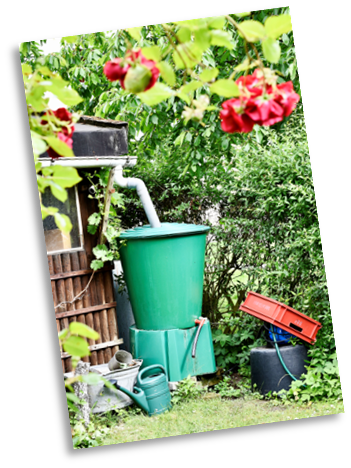Saving Water
In spite of the somewhat soggy spring water is an increasingly precious resource in the UK. Over the past few decades, rivers, reservoirs, and ground water supplies have become depleted. It’s important to save water where we can. Most of us have enough space for at least one water butt, and there are slimline versions for smaller plots. Connect them to every available downpipe around your house! Fit guttering to sheds and summer houses to allow even more water collection. Keep the butts covered to prevent leaves falling in and deter mosquitos from breeding.
Bulk up soil with organic matter, such as compost and leaf mould. This improves free-draining soil particularly, but most soil types will benefit. It prevents clay soil baking hard and damaging roots, and on boggy soil it improves drainage and oxygenation. It’s win-win, whatever soil you garden on.
Water during cooler parts of the day. A good soak every few days is better than little and often, because when only the surface is wet most of the water evaporates or drains away. Also, water only at critical stages like germination, or when you’ve just transplanted young plants with immature root systems, or when fruit is setting such as tomatoes or strawberries.
Bare soil loses moisture quickly through evaporation so mulch, mulch, mulch. Use straw, grass clippings or leaf mould. Mulching has the added benefit of smothering weeds. A green lawn looks lush, but no-one should be watering a lawn nowadays. Yes it will yellow, but lawns are tough and will green up at the first sign of rain.
I retired my sprinkler system years ago. Sprinklers are wasteful and it’s better to implement targeted watering or even a slow drip-irrigation system. Work with your garden rather than against it. My free-draining lime soil favours plants such as lavenders and other silver-leaved species. If you garden on clay you might choose roses or ribes sanguineum and Malus (crab apples).
Greenhouses can be a major source of water wastage. Never place pots directly on to staging. Instead use capillary matting or trays to capture run-off and enable plants to access this when needed.
The only time you shouldn’t use rainwater is with seedlings. They are vulnerable a variety of fungal infections called which fall under the catchall phrase, ‘damping off disease’. Tap water only is recommended for seedlings. But once they are potted up, you can switch to harvested rainwater.
‘Grey’ water is water from washing up or washing vegetables, or even bathwater. Collecting it can be a good idea providing you take certain precautions. There are plenty of tutorials on YouTube to help you make the most of your own grey water. Use rinsing water only or eco products free from phosphates which are harmful to the microflora in the soil. Bathwater should not be stored for too long and should only be used to water flowers, never edible crops, because of the risk of bacterial growth harmful to humans if ingested.
I hope this has inspired you to save water in your garden this summer. Happy gardening.

